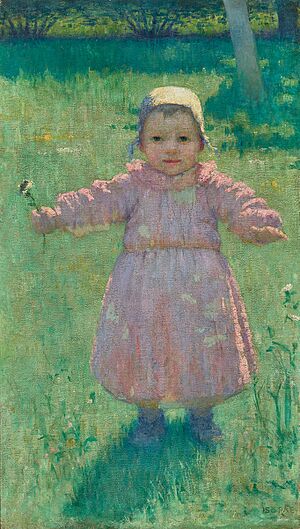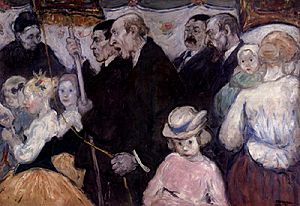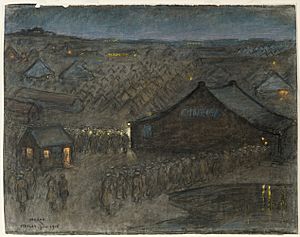Iso Rae facts for kids
Quick facts for kids
Iso Rae
|
|
|---|---|
| Born | 18 August 1860 Melbourne, Victoria, Australia
|
| Died | 16 March 1940 (aged 79) Brighton, England
|
| Education |
|
| Known for | Painting, drawing |
|
Notable work
|
Rogation Sunday (1913) |
| Movement | Impressionism |
Isobel Rae (born August 18, 1860 – died March 16, 1940) was an Australian artist. She was known for her impressionist paintings.
After studying art in Melbourne, Australia, Isobel Rae moved to France in 1887 with her family. She lived there for most of her life. Rae became a key member of the Étaples art colony, a group of artists who lived and worked in the fishing village of Étaples.
Her paintings were shown in famous art exhibitions like the Royal Society of British Artists and the Paris Salon. During World War I, she helped out as a volunteer. She was one of only two Australian women artists who stayed in France and painted during the war.
Contents
Becoming an Artist: Isobel Rae's Early Life

Isobel Rae was born on August 18, 1860, in Melbourne, Australia. She was the youngest daughter of Thomas Rae, a Scottish businessman and politician, and his wife Janet Love.
Isobel studied art at the National Gallery of Victoria Art School from 1877 to 1887. She learned alongside other famous artists like Rupert Bunny and John Longstaff. Her teachers included George Folingsby. She won awards for her art while she was a student.
Rae also joined the Victorian Academy of Arts and the Buonarotti Club. These groups allowed her to show her art and meet other creative people.
Moving to France: A New Artistic Home
In 1887, Isobel Rae moved to Paris, France, with her mother and sister. They lived there for three years. After that, they moved to the fishing village of Étaples in northern France. This village was a popular place for artists.
Even though she lived in Europe, Rae still showed her art in Australia and New Zealand. Her paintings, especially landscapes, were displayed in exhibitions.
Life and Art in the Étaples Colony
Isobel Rae lived in the Étaples art colony for a long time. She worked with many other Australian artists there, including Hilda Rix Nicholas and Rupert Bunny. She also met French artists like Jules Adler.
In the late 1890s, Rae often showed her paintings at the Royal Society of British Artists. Her art often showed everyday scenes. For example, she once won a prize for a painting of a Chinese street seller. Another painting showed a working-class girl carrying water at night.
Rae also regularly showed her art at the Paris Salon, a very important art exhibition in Paris. Australian newspapers often reported her success. Her paintings were displayed there many times between 1908 and 1914. Sometimes, her sister Alison's artwork was also shown.
Documenting World War I
When World War I started, many artists left France. However, Isobel Rae stayed. She and Jessie Traill were the only two Australian women artists who lived and painted in France during the war.
Rae became a member of the Voluntary Aid Detachment. This group helped out during the war. She created over 200 drawings that showed what life was like during the war. Most of these drawings were of the Étaples Army Base Camp. This was a huge British army camp that housed up to 100,000 people.
Many of her drawings show scenes at night. This might be because she worked during the day. Even though she documented the war so well, she was not chosen as an official Australian war artist. Art experts believe her works were seen as "too personal" at the time.
A museum expert named Betty Snowden looked at Rae's World War I drawings. She noticed how Rae used a style similar to Post-Impressionism. This style uses strong outlines and flat areas of color.
Snowden also said that Rae's drawings showed the strict rules and tension of army camp life. They often showed people waiting. They were waiting for battle, waiting for the war to end, or waiting to go home.
The Australian War Memorial has eleven of Rae's artworks. One famous piece is Cinema Queue. It shows a dramatic night scene with bright lights against the dark. It captures the long line of men waiting, showing the feeling of waiting that was common in the camp.
Rae's mother died in France during the war. Isobel and her sister stayed in France until the 1930s. When Adolf Hitler came to power, they moved to England. Isobel Rae died in Brighton, England, on March 16, 1940.
Isobel Rae's Artistic Impact
People had different opinions about Isobel Rae's art. Some thought her impressionist style was too strong. Others found her use of color charming and lively.
Even though she wasn't included in some important art books about Australian women artists, her paintings are still valued. One of her works sold for 10,000 Euros in 2012.
Isobel Rae's art can be found in major collections. These include the National Gallery of Australia, the National Gallery of Victoria, and the Australian War Memorial. Her work is also in the Musée du Touquet in France.



